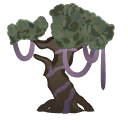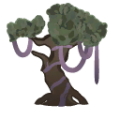Difference between revisions of "Polux tree"
| Line 38: | Line 38: | ||
*Is only 20% as fast as a [[Wastepack atomizer]]. | *Is only 20% as fast as a [[Wastepack atomizer]]. | ||
| − | Polux trees are considered "super", meaning that pawns with the [[Ideoligion#Trees|Trees: Desired precept]]{{IdeologyIcon}} will receive the "amazing tree" thought after seeing one. Unlike the anima and gauranlen trees, Polux trees will still be eaten by [[thrumbo]]s. All trees can also be eaten by [[alphabeaver]]s. | + | Polux trees are considered "super", meaning that pawns with the [[Ideoligion#Trees|Trees: Desired precept]]{{IdeologyIcon}} will receive the "amazing tree" thought after seeing one. Unlike the anima and gauranlen trees, Polux trees will still be eaten by [[thrumbo]]s. All trees can also be eaten by [[alphabeaver]]s. They are immune to [[blight]]. |
== Analysis == | == Analysis == | ||
Revision as of 00:46, 15 December 2022
| This article relates to content added by Biotech (DLC). Please note that it will not be present without the DLC enabled. |
| This article is a stub. You can help RimWorld Wiki by expanding it. Reason: Artificial building mechanics, analysis. |
Polux tree
After generations of exposure, these trees have evolved to metabolize pollutants. By drawing pollutants from the ground through wide root networks, they slowly clean polluted terrain in their vicinity. However, they cannot do this if buildings are constructed over their roots.
Unlike most methods of cleaning polluted terrain, polux trees do not create toxic wastepacks.
Base Stats
Plant Stats
Polux Trees are a type of tree which grows within polluted environments. The trees themselves slowly absorb pollution from the surrounding environment in an area similar to a pollution pump (7 tile wide circle), Unlike pollution pumps, Polux trees do not generate any toxic wastepacks after absorbing the surrounding pollution. This makes them a safer way to remove pollution.
Growing
Like the Anima tree![]() and the Gauranlen tree
and the Gauranlen tree![]() , the polux tree does not naturally occur in any ecology, instead being spawned by the "polux tree" event[When?].
, the polux tree does not naturally occur in any ecology, instead being spawned by the "polux tree" event[When?].
When settling on a polluted map, a polux trees may already be present. Further, polux trees can spawn on maps colonized by the player when they are polluted. Every 15 days, the current polution level and current tree population is checked. If below the assinged value a tree may be spawned.
- No pollution (0-25%): 0 polux trees
- Light pollution (25%-50%): 0 polux trees
- Moderate pollution (50%-75%): 1 polux tree
- Extreme pollution = (75%-100%): 3 polux trees
Polux trees never spawn within 16 tiles of each other.
Polux seeds can also be bought from traders or obtained from quest rewards.[Other ways?]
Summary
- Cleans 1 tile of pollution every 25,000 ticks (10 in-game hours).
- Needs 150,000 ticks (2.5 in-game days) to clean 1 deteriorated Toxic wastepack (6 tiles).
- Is only 20% as fast as a Wastepack atomizer.
Polux trees are considered "super", meaning that pawns with the Trees: Desired precept![]() will receive the "amazing tree" thought after seeing one. Unlike the anima and gauranlen trees, Polux trees will still be eaten by thrumbos. All trees can also be eaten by alphabeavers. They are immune to blight.
will receive the "amazing tree" thought after seeing one. Unlike the anima and gauranlen trees, Polux trees will still be eaten by thrumbos. All trees can also be eaten by alphabeavers. They are immune to blight.
Analysis
| This section is a stub. You can help RimWorld Wiki by expanding it. Reason: General also what is there is rough. |
The easiest way to use pollux trees is to plant them nearby and leave toxic wastepacks in a stockpile zone next the tree. Wastepacks outdoors deteriorate into pollution every 8 days assuming no rain or cold temperatures, creating 6 tiles of pollution.
In 8 days, a polux tree cleans 19.2 tiles. Meaning that a single pollux tree can have a stockpile of 3.2 stacks of wastepacks deteriorating without being overwhelmed. However, this assumes that no rain ever increases the deteriorating rate of the packs. To avoid this, consider placing the stockpile next to a natural rock face to act as a support for a roof to cover the stockpile
Gallery
Version history
- Biotech DLC Release - Added.
- 1.4.3555 - Polux tree seeds introduced, which can be planted on polluted ground.



